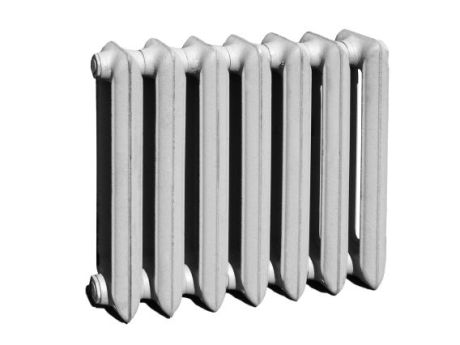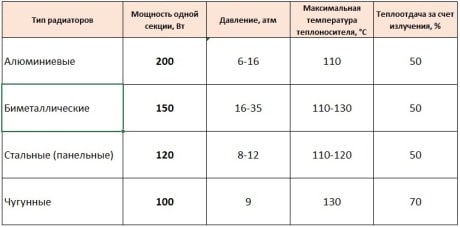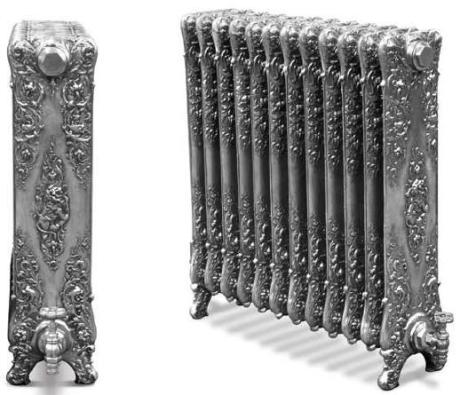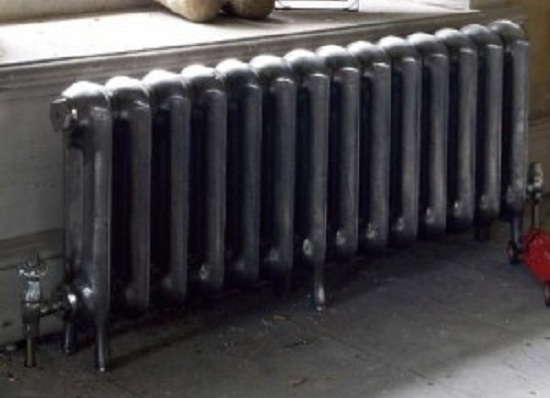The life of cast-iron radiators. Cast iron radiators - time-tested equipment
Cast-iron batteries have been known for more than a century and a half, and according to all the laws of the evolution of technology, they should have disappeared from use long ago. Nevertheless, they can still be found in modern apartments and private houses. Over time, the design changes, new designs appear, but cast-iron heaters still break record records. What are the advantages of a new model of cast iron batteries? Does it make sense to put them now, when the choice of radiators is so great?
Cast iron radiators in a modern minimalist interior
Varieties and design features of cast iron radiators
Each battery consists of several cast sections. They are made of gray cast iron. Inside the sections there are channels along which the coolant moves. The cross section of the channels is round or ellipsoidal. The sections are interconnected by nipples. To prevent joints from leaking, they are additionally sealed with special gaskets - usually paronitic or rubber.
Depending on the number of channels inside the sections, several types of batteries are distinguished:
- single channel;
- two-channel;
- three-channel.
Manufacturers produce heating appliances of various sizes, with a different number of sections. The main technical characteristic, power, depends on the parameters of radiators. The height of the devices ranges from 35 to 150 cm, the depth is 50-140 cm.
As for the location and type of mounting, the cast-iron radiators are mainly wall mounted, they are mounted under the window sills on powerful brackets. But in recent years, manufacturers are increasingly placing on the market floor models that are equipped with legs. This is a convenient option, because cast iron is very heavy, it can not be mounted on all types of walls.

Positive properties of cast iron radiators
In some apartments, to this day are the very first models of cast-iron radiators, which are already about a hundred years old. A real rarity! And the owners are in no hurry to replace heating appliances with more modern ones. Such a “commitment to traditions” is purely practical in nature, because even some of the shortcomings of cast iron are actually virtues.
Long-lived batteries - the secret to their popularity
- Resistance to aggressive coolant. In district heating networks, water quality is poor. The owner of the apartment can neither control him, nor change, you have to adapt to the circumstances - look for radiators that are resistant to corrosion, chemical and mechanical stress. Thick walls of cast iron batteries are not sensitive to constant friction created by small particles in the water. When the coolant is drained for the summer, the material does not lend itself to corrosion.
- High working pressure. Water hammering and high pressure in centralized systems are another test for radiators in apartment buildings. Cast iron withstands 9 atmospheres, does not burst during pressure surges.
- Durability. Practical experience shows that the actual service life of cast-iron heating batteries can be several decades. Often they are replaced not at all because they are out of order, but simply because of the “non-modern” type of heating appliances and the desire to decorate the interior with more aesthetic radiators. If you properly care for the batteries, they can work properly for half a century or more.
- Reasonable price. In terms of strength and resistance to negative impacts, only bimetal can be compared with cast iron. The price difference between the radiators of these materials is huge. When replacing the batteries in all rooms, the savings are significant, so many owners of the premises choose a budget option. Bimetal heating appliances are beautiful, efficient, but too expensive.

Cast Iron Batteries - Strong, Reliable, and Durable
"Disguised" under the disadvantages of dignity
- High inertia. Thick cast-iron walls of radiators warm up for a long time, in contrast to thin-walled modern models. The initial heating of all rooms takes a lot of time. But is it a disadvantage? By and large, the heating rate matters only once a year - at the very beginning of the heating season. Then, for several months, this characteristic does not affect the thermal regime. On the contrary, high inertia becomes a serious plus in the event of an emergency shutdown of heating, because the room does not cool down for a long time.
- Low heat transfer rate. The power of one section of a cast-iron battery is on average 110 watts. This is lower than that of steel or aluminum models, not to mention bimetallic ones. It would seem that the power is small, the heating rate is low - obvious disadvantages. But not so simple. Cast iron batteries are heated mainly by radiation, i.e. not only air, but also objects in the room, which also in turn begin to give off heat. As a result, heating is obtained better than when heating with other types of radiators. Therefore, it is hardly worth attributing this property to disadvantages.

Table of power and heat transfer of radiators from different materials
Clear flaws: is it worth it to focus on
A lot of weight. This feature of cast iron gives a lot of trouble to apartment owners, because batteries are really hard to transport, carry and install. To cope with this shortcoming will not work. It remains to be comforted in the fact that a lot of weight is the thick walls of the device that will warm well on winter evenings. In addition, they mount batteries every few decades, so you can pay loaders and installers for hard work.
A large volume of coolant. Compared with aluminum models, which need 0.4 liters of water for operation, 0.9 liters for cast-iron seems a lot. On the other hand, if for owners of private houses this may still matter, then owners of apartments with centralized heating do not care what amount of water the heat supplier warms up.
Ugly appearance. Yes, you can not look indifferently at the radiator, if with its wretched appearance it really spoils the entire interior. But this is not the end of the world, because the batteries can be hidden with curtains or special screens, decorated. Some owners of apartments with such batteries show miracles of fantasy, decorating them with elaborate drawings, funny figures, etc. Option - purchase of luxurious modern models made in retro style. It is very beautiful, albeit expensive.

Decorating a battery with decoupage technique - do-it-yourself beauty
Differences of cast-iron heating batteries of foreign and Russian production
Russian cast-iron batteries compete with imported ones. With regard to technical characteristics, they are often inferior to products of foreign brands. The classic cast iron radiator MS-140 is designed for a working pressure of 9 atmospheres, pressure testing - 15. You can find German, Italian and Czech models with the best performance. In addition, they have smoother surfaces. Less heat transfer is required to fill. If we compare the MC-140 with the TERMO model of the Czech brand Viadrus, we see that the first “absorb” 1.3 liters, and the second 0.8 liters with equal declared capacity. The only advantage of Russian products is that it is cheaper.

Decorated "antique" German-made cast-iron battery
When buying radiators, it makes sense to pay attention to cast-iron models. They are really worth the money spent. The calculation of the power needed for heating a room is very simple: for heating 10 sq.m. need 1-1.3 kW. Calculate how many sections are enough to heat each room, and select the appropriate cast-iron radiators, focusing on the technical specifications in the documentation.
Text: Vyacheslav Bereznichenko
If in winter the quality of the batteries left much to be desired, now is the best time to change them. Firstly, it is not necessary to remain without heating for the duration of the work. Secondly, the work will cost less.
After the end of the heating season, many firms repairing and installing heating systems introduced discounts on their services. Discounts reach up to 25%, and with a comprehensive replacement of the heating system (all batteries and riser), some even offer the replacement of every third radiator for free.
There is a reason
The reasons for changing old batteries to new ones can be different. For example, the expiration of the service life. The maximum service life of a water heating radiator is 35 years. But such a term can honestly serve the owners of the battery only in ideal operating conditions, which is hardly possible in domestic networks. Devices and so work in an aggressive environment (high temperature, pressure), and all the more difficult for them due to insufficient quality of the composition of the coolant, the mode of its supply (critical pressure surges). All of these sin urban heating systems.
Another reason for replacement - the device does not cope with the task assigned to it, it gives off too little heat. This can happen for two reasons: either from the very beginning the device that was not suitable for this room was chosen, or the channels of the device were overgrown with rust. In the latter case, the battery may be repairable, and it is not necessary to change it. At least for a while. In any case, the radiator should be shown to a specialist. It is good if the specialist is from close friends. Confidential relations are very important here, as the masters invited from companies often tend to exaggerate in order to convince the owner of the apartment to completely replace the radiators.
Also, the appearance of old batteries can serve as a reason for replacement. Cast-iron "accordions" or steel panel radiators, which have been installed everywhere in residential buildings over the past decades, could be fed up with their unpretentious design. The modern market offers a wide selection of devices of various designs up to the most bizarre forms.
Size matters
The customer chooses and buys radiators for his apartment. The main selection criterion is usually the appearance of the device. An inexperienced apartment owner evaluates the device by eye. For example, the radiator is much larger in size than its old battery, which means it will be warmer in the house. And with the onset of the heating season, it may suddenly become clear that the house was not just warmer, it was hot. As a result, in winter you will have to open the windows much more often than necessary for ventilation. In this case, there is no need to talk about comfort. It can happen and vice versa - a large radiator will be less powerful than the previous small one that was thrown away. In a word, you need to know a little more about water heating radiators.
Radiators are classified depending on the principle of heat transfer to the room: sectional, tubular, panel radiators, as well as convectors. They also differ in the material from which they are made. They can be cast iron, steel, aluminum and bimetal.
Sectional radiators are old cast-iron "accordions" familiar from childhood. However, the modern assortment of sectional radiators is much wider. They have long been made of other metals, but cast iron is leading. "Accordions" are the most durable and inexpensive devices. Although there are exclusive cast models in retro style, and they are very expensive.
Tubular radiators are a design of two collectors connected by vertically curved metal tubes. Bends are made in order to, especially not greatly increasing the dimensions of the device, increase its efficiency - increase the area of \u200b\u200bthe heating surface. In many of these models, developers combine business with pleasure. It is on these types of devices that the majority of the so-called design radiators account for - they are given various shapes, and the pipes are bent so that sometimes not immediately and you will guess the direct purpose of the resulting design. Such models are among the most expensive.
For panel radiators, the heating element is a metal, most often steel, panel, inside which a channel for a coolant is provided. Due to the large area of \u200b\u200bthe heating surface, such radiators have good efficiency, although they seem barely warm to the touch. Radiators of this type do not provide rich scope for design fantasies, but they are inexpensive.
All three types of devices mentioned above transfer heat to the room according to the principle of radiation. The latter type of radiator, convector, another principle of heat transfer - the natural circulation of heated air. Convectors are metal tubes with thin plates attached to them (fins). The heat carrier heats the tubes, those, in turn, the plates. Heated air between the plates rises.
The plates have a very small area, therefore, are very hot. If the temperature of the coolant is too high, then in contact with them a person may even get a slight burn. Therefore, the fins are covered with a protective panel, due to which the convector can sometimes be confused with a panel radiator.
The advantage of convectors over radiation devices is that, being high-temperature, they have small dimensions. Due to this, in particular, they are used in apartments with low window sills.
One hundred per cube
In order for the device to create a comfortable temperature in the room, you need to choose the optimal power. Unlike electric heaters, where you can adjust the power with a thermostat, radiators included in the open water heating system (it is in most city apartments) do not have such a function. Thermostats are only possible in autonomous systems. These are equipped with cottages and only sometimes urban multi-storey buildings, and then from the category of elite.
In ordinary apartments, the temperature of the coolant depends only on the energy supplying organization. According to the standards, it should be 70 0 С.
When choosing a radiator, you need to look at the technical data sheet of the product, which indicates the power of the device, subject to the standard temperature of the coolant. The most approximate idea of \u200b\u200bthe required power of the device gives the simplest formula: the area of \u200b\u200bthe room, multiplied by 100 watts. That is, for a room, for example, an area of \u200b\u200b15 square meters. m will need a device with a power of 1.5 kW.
However, this formula is applicable only for rooms with a ceiling height of 2.8-3 meters, and the height is both greater and less. Therefore, it will be more accurate to calculate not by area, but by volume - 100 W per the number of cubic meters.
Cramped yes hurt
In principle, such an approach should be sufficient, although a small error is not excluded. The most scrupulous citizens who want to choose the perfect option will have to turn to specialists in the company that sells and installs climate equipment. Everything will be taken into account there. Not only the volume of the room, but also the size of the window openings, the presence or absence of double-glazed windows, they will consider the approximate ventilation mode of the room, based on the number of people spending a lot of time in this room, other heat sources will also be taken into account (for example, the back wall of the refrigerator is also in some kind of sense is a heater), and so on.
Do not blindly believe the advertisement, where they promise "promotions only until the end of the month", which will replace radiators at 800 rubles apiece (without the cost of the radiator itself). Advertisers do not lie, but the price mentioned includes only delivery and installation of the device at a place already prepared for this. And above this price you will have to pay for the dismantling of old radiators, replacement, if required, of pipes, and much more. In the price lists for a service, for example, the so-called tightness factor is taken into account - if there are any inconveniences for installation, then the price rises by 20-40%.
The exact cost of replacing radiators in an apartment “by eye” is impossible to assess. This requires the preparation of a detailed cost estimate. A rough idea of \u200b\u200bthe upcoming costs can be obtained from the enlarged estimates. Replacing one battery will cost the customer 4-5 thousand rubles. However, they rarely change one at a time, and the more batteries to be replaced, the lower the "unit price". In any case, the estimate is approved by the customer, and if the service seems too expensive, you can contact another contractor.
The average cost of replacing heating radiators
The first cast-iron water heater was, in modern terms, announced in 1857 in Russia by engineer Franz Sangalli. It was made of a cast-iron pipe equipped with protruding ribs for heat removal. A few years later, the cast-iron radiator was modified and acquired the configuration of an “accordion,” which later became traditional in the 20th century.
Hot water heating from a nearby boiler house quickly became the dominant way of heating residential and office buildings in imperial Russia. In some of them, cast-iron radiators, which have become rarities, still maintain a healthy state, which emphasizes the long service life of cast-iron radiators. Conducting regular maintenance of heating batteries, flushing sections and periodically replacing intersectional gaskets will bring the life of cast iron batteries to 50 years and above.
Advantages of cast iron batteries over other materials
At the dawn of the appearance of cast-iron radiators, no one made comparisons of their performance with radiators from other materials, since there was nothing to compare with. In Soviet times, there was no alternative to the "accordions" of the MS-90 and MS-140 for more than half a century, only recently steel and aluminum batteries appeared, which were absolutely not adapted to our central heating. Until now, most apartments are heated by cast-iron heating batteries, but the point here is not the conservatism of consumers, but those indisputable advantages that cast-iron models have.
- Excellent abrasion resistance and corrosion inertness in relation to salt impurities and rust particles from worn pipes contained in the coolant.
- The same chemical stability favorably distinguishes cast iron during the off-season “heating holidays” when the coolant is drained and the internal radiator cavities remain dehydrated for more than two weeks and are subjected to oxidizing aggression by oxygen from the air.
- The main part (up to 70%) of the released thermal energy is accounted for by radiation, which ensures uniform heating of the apartment space.
- By changing the number of sections, you can achieve the desired indoor climate.
- Simple installation that does not require special fasteners. For most consumers, radiators are suspended from fittings driven into the wall.
- The sectional design allows the repair of cast-iron radiators by replacing an unusable section instead of acquiring a whole radiator.
- Cast iron is not susceptible to oxidation due to mechanical damage such as scratches and chips, so even a simple, neat painting of the outer surface gives the battery a decent look. You can install cast-iron batteries in any production room, including those with high humidity, chemical plant workshops, warehouses, garages, in general, wherever convenient.
Cast iron battery flushing
It is difficult to imagine the quality of hot water in heating systems of the late 19th - early 20th centuries, but the contamination with chemical impurities and rusty turbidity of the current coolant is known to everyone. When drying during the off-season period, a rusty suspension settles on the inner walls of the pipes and the cavity of the radiators, clogging the passage section. Over the year, the layer grows to several millimeters. The heat transfer power is reduced by almost 50%. 
Over time, the unimpeded circulation of the hot heat carrier is more and more difficult due to the increase in hydraulic resistance in the narrowed passage section. Therefore, the removal of accumulated dirt from the radiator is the main type of maintenance of radiators.
- chemical;
- hydropneumatic;
- conventional hydraulic;
- flushing with disassembly of the radiator.
The first three methods are designed to clean the communications of the central heating system by the housing and communal services, have a regulated frequency and require special material support. The washing of the disassembled sections of the radiator is used in everyday life when the radiator is disassembled on its own and thoroughly cleaned of the accumulated dirt of the internal volume of the sections.
It is not at all necessary to hire an uncle Vasya, an abstract plumber, who knows how to remove a cast-iron heating battery in order to then disassemble and wash it. After making sure that there is no water in the riser, it is not at all difficult to disconnect the joints at the joints from the riser pipe and remove the battery from the reinforcing hooks. The removed radiator is washed from the hose with a stream of water directed in the direction opposite to the direction of the coolant flow. It is necessary to rinse until clear water flows from the radiator, which does not have rust and dirt.
Another way to flush is to fill the radiator with hot water containing a cleaning agent such as caustic soda, cover with plugs and leave for an hour. Then knock on the walls of the radiator with a wooden hammer, shake the battery, several times you can transfer it from side to side. Rusty sediments should exfoliate and leave with poured water.
It is important! Cast iron is a brittle material, so tapping the walls must be done with a wooden hammer. The impact of a metal hammer can damage the radiator walls. Hidden cracks are stress concentrators, which, with increasing pressure in the network, can destroy the battery.
The procedure itself, how to disassemble a cast-iron sectional radiator, does not have any approved guidelines for its implementation, therefore, all actions
Dismantling and disassembling the cast iron battery
The end caps are unscrewed, and then the nipples between the sections. Often the legs and sections become very sticky, you have to apply force so that the sticky foot turns. When the radiator appears in the form of simple cast-iron parts, each of them is cleaned of rust deposits by any mechanical means available. Cast iron is not afraid of scratches, so you can chip or beat off unsuitable sticky pieces of hardened dirt. 
When the radiator is temporarily removed from the heating system, it is necessary to use this situation to understaff the battery with additional sections. Calculation of cast-iron heaters to determine the optimal number of sections is simple. We use the required value of 100 watts for heating 1 square. meters of housing and the minimum heat transfer of 125 W section indicated in the passport of a cast-iron "accordion"
For a large room of 24 square meters. meter will need at least:
24 x 100 \u003d 2400 W of thermal energy.
It can be obtained from:
2400/125 \u003d 19.2 pieces of sections. We round up with a margin up. So, you need at least 20 sections, which is equivalent to two ten-section cast-iron batteries.
After determining the required number of sections, it remains to decide how to build up the batteries in accordance with the size of the windows and their location. Radiators are unified for any version of pipe routing to the riser, having two end points for connection in the design. The threaded inlets are screwed away from rust and dirt and screwed into nipples with gaskets made of paronite or rubber and pressed in to connect the next section.
Washing the batteries every two to three years in such a simple way will help to extend the life of cast iron batteries, which, as mentioned above, can be used for more than half a century during basic maintenance.
